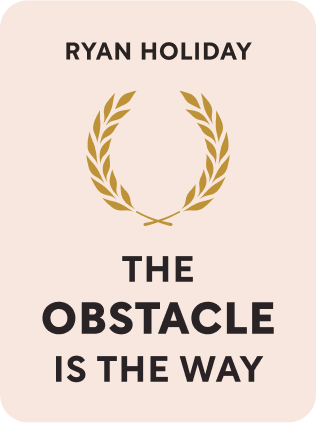

This article is an excerpt from the Shortform book guide to "The Obstacle Is The Way" by Ryan Holiday. Shortform has the world's best summaries and analyses of books you should be reading.
Like this article? Sign up for a free trial here .
What is Ryan Holiday’s The Obstacle Is the Way about? What are the key themes discussed in the book?
In The Obstacle Is the Way, Ryan Holiday explains how to apply the principles of Stoicism to overcoming challenges in everyday life. The book is packed with anecdotes that illustrate how these principles have been applied in practice by some of the greatest minds in history.
Here is a brief overview of The Obstacle Is the Way by Ryan Holiday.
Ryan Holiday: The Obstacle Is the Way
In The Obstacle Is the Way, Ryan Holiday unpacks the ancient wisdom of Stoicism into simple yet powerful life lessons. Starting with one of the earliest practitioners, Roman emperor Marcus Aurelius, Holiday shows how successful people throughout history managed in the Stoic tradition to thrive, not only despite, but also because of the obstacles they encountered. Marcus, who ruled the Roman empire for 19 years, embodied and articulated this approach to overcoming obstacles, writing:
The impediment to action advances action
What stands in the way becomes the way
The approach of the Stoics encompasses three interconnected disciplines: 1) perception, 2) action, and 3) will.
In The Obstacle Is the Way, Ryan Holiday distills the key principles of the three Stoicism disciplines, accompanying his explanations with real-world anecdotes of how the most successful people in history have applied them to overcome the most difficult or even impossible challenges.
What follows is a brief overview of the key themes covered in the book, specifically the three disciplines of Stoicism and their key principles. You can read the full summary of The Obstacle is the Way by Ryan Holiday here.
The Discipline of Perception
Perception is how we see the world around us. Typically, we assign meaning to events—for instance, whether they’re good or bad. In contrast, Stoics view events neutrally (as they are) so they can better understand them.
Our perceptions can hinder or help us. If we’re emotional and self-centered, and therefore see things through that lens, we’ll always have problems that seem overwhelming. However, when we learn to view things dispassionately and curiously, this gives us an edge over obstacles and a chance to turn them to our advantage.
Key Principles of Perception
Learn from crises: Rather than being distracted or misdirected by fear, view crises as learning opportunities. Observe and study them dispassionately; learn from others’ mistakes and take advantage of them.
Exercise your power: You’re never powerless; whatever the situation, you control how you perceive it and how you respond. Therefore, you have the power to transform every experience or obstacle and also yourself.
Focus on what you can change: Understand what’s within your control and what isn’t, and focus on the things you can do something about. For instance, you can’t control the economy, weather, disasters, or other people’s feelings and actions. But you can control your attitude, emotions, judgments, and responses. You control how you see and respond to obstacles.
Think differently: Your perceptions often determine what you accomplish—if an obstacle looms bigger in your mind than the goal, it will stop you. Instead of listening to naysayers, and therefore accomplishing little or nothing, think differently.
Turn obstacles upside down: In every situation or obstacle, there’s a hidden opportunity that you can turn to your own benefit; learn to flip the obstacle upside down so you can see it.
The Discipline of Action
Once you’ve managed your perceptions and seen your obstacle objectively, the next step is to act. Not rashly, however—“right action” is a discipline. It has three attributes: deliberateness, boldness, and persistence. Deliberate step-by-step action breaks down obstacles.
Key Principles of Action
Get going: Everyone who accomplished great things in history began by telling themselves, “Let’s go”—usually in more challenging circumstances than we face. They didn’t wait for perfect conditions. Similarly, you need to just get the ball rolling.
Be persistent: The way to attack obstacles is to “persist and resist.” Approach them with calmness, patience, and determination. Realize you’re in it for the long haul and never think of quitting.
Do what works: Often, the best way to get things done is to be a pragmatist—adapt your approach to the circumstances and do whatever works. Because action is the only way to break apart obstacles, getting results is more important than your method.
Turn obstacles against themselves: Some obstacles may be insurmountable—you really can’t defeat them. But you still have another option: Get them to defeat themselves; turn their own strength against them. Alexander the Great tamed the mighty horse Bucephalus by simply mounting and hanging on until the horse tired of fighting.
The Discipline of Will
The final discipline of Stoicism is will. The first two disciplines derive from the mind and body. Will comes from the heart.
Will is completely under your control. It can’t be stopped or affected by outside forces. When an obstacle or situation blocks your actions, you can exert will to transform the situation into something that benefits you.
Key Principles of Will:
Create an inner citadel: Stoics build a mental “Inner Citadel” impervious to adversity, and actively maintain and reinforce it. This means strengthening yourself mentally and physically during good times so you have the strength you need during bad times.
Practice acceptance: When you face a problem or situation you can’t control, the only thing you can do is accept it. Stoics refer to this as the art of acquiescence. Once you face the facts, you can very likely use the problem or challenge to your benefit.
Love whatever happens: The next step after acceptance is to love and find joy in what happens, good or bad. Setbacks and disasters in life are inevitable—you have to face up to them, so you might as well do it with joie de vivre.
Persevere: Perseverance is having the endurance to tackle a series of obstacles without quitting until you reach your goal, even if it takes years.
Have a larger purpose: When stuck in a situation you can’t control, often the best way to get through it is to ask yourself how you can at least help others if you can’t help yourself. If you just focus on yourself and why bad things keep happening to you, you’ll stay stuck. But when you realize your ability to do some good, you’ll feel empowered.
Ryan Holiday: The Obstacle Paves the Way
Every obstacle, without exception, offers an opportunity. Even if the only benefit you can derive from an obstacle is to practice forgiveness or some virtue, you’ve gained something of value.
In each of the stories that Ryan Holiday recounts in The Obstacle is the Way, someone overcame an obstacle, not necessarily in the way they initially intended, and they became better and stronger people. They unlocked powers that are available to everyone: those of perception, action, and will. They require you to:
- See things as they are.
- Take the right action.
- Persevere and accept the world as it is.
You don’t have to master all three Stoic disciplines at once; just learn and build strength as you go. You’re just as capable as anyone in history.

———End of Preview———
Like what you just read? Read the rest of the world's best book summary and analysis of Ryan Holiday's "The Obstacle Is The Way" at Shortform .
Here's what you'll find in our full The Obstacle Is The Way summary :
- Why you should think of any obstacles as opportunities
- How Stoicism can show you the way to overcome challenges
- How Theodore Roosevelt's struggle with asthma prepared him for future struggles






